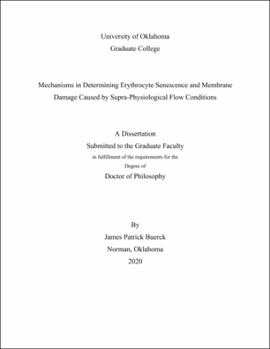| dc.description.abstract | Incidence of cardiovascular diseases (CVDs) is growing more prevalent in today’s society as a result of changes of three basic factors: the increasing age of the general population, declines in mortality as a result of these CVDs and increasing rate of obesity. As we see the predictable increase in CVDs across the population, the current gold standard for treatment of heart transplant becomes less viable. Therefor the current solution of implanted devices such as Ventricular Assist Devices (VADs) and prosthetic heart valves to either alleviate work required by the heart will become increasingly more common. Since their early use, the level of blood damage seen as a result of VAD implantation has steadily decreased to near negligible amounts of hemolysis. However there still exists sublethal shear effects to red blood cells (RBCs) which may cause any number of serious problems for patients.
The overall goal of this research was to gauge the extent of which sub-hemolytic shear forces affect RBCs and to further determine how these consequences may affect continued normal biological function. Observed changes may also be of value in monitoring the status of patients with medical devices that expose blood to high shear rates. The results of this thesis can be categorized into three general topics.
The first discussed topic is the production of shear-induced erythrocyte microparticles (ErMPs). Microparticles (MPs) are produced by various cells due to a number of different stimuli in the circulatory system. Shear stress has been shown to injure red blood cells resulting in hemolysis or non-reversible sub-hemolytic damage. It is hypothesized that, in the sub-hemolytic shear range, there exist sufficient mechanical stimuli for RBCs to respond with production of ErMPs. RBCs isolated from blood of healthy volunteers were exposed to high shear stress in a microfluidic channel to mimic mechanical trauma similar to that occurring in ventricular assist devices. In these studies we looked at the concentration of ErMPs after exposure to subhemolytic shear stresses in microfluidic channels. The concentration of shed ErMPs after shear had an upward trend from a control concentration of 5,900 ± 700 ErMP/µL to 64,000 ± 16,000 ErMP/µL after just 15ms exposure of 100,000 s-1. Increasing the shear rate from 50,000s-1 to 150,000s-1 (exposure time of 10 ms) gave an increase from 9,700±1,100 ErMP/µL to 35,000 ±1,700 ErMP/µL over the control concentration. These results led us to look at other possible responses by RBCs to shear similar to that observed in VAD patients.
RBCs passing through heart pumps, prosthetic heart valves and other cardiovascular devices undergo early senescence attributed to non-physiologic forces. We hypothesized that mechanical trauma accelerates aging by deformation of membrane proteins to cause binding of naturally occurring or native IgG. RBCs isolated from blood of healthy volunteers were exposed to high shear stress in a viscometer or microfluidics channel to mimic mechanical trauma and then incubated with autologous plasma. Increased binding of IgG was observed indicating forces caused conformational or other changes in a membrane protein exposing an epitope(s), likely the senescent cell antigen of band 3. The binding of immunoglobulin suggests it plays a role in the premature sequestration and phagocytosis of mechanically traumatized RBCs in the spleen. Measurement of IgG holds promise as a marker foreshadowing complications in cardiovascular patients and as a means to improve the design of medical devices in which RBCs are susceptible to sublethal trauma. Keeping a view on the concentration of ErMPs as well as IgG positive RBCs could assist in curving further patient complications.
The effects that the ErMPs had on thrombus structure was another area of investigation to examine. Activity of MPs in vivo has long been studied and shown to have activity in thrombus promotion and generation. In our study, it was found that ErMPs have the ability to alter the formation of the fibrin network in a thrombus and further affect clot properties such as hydraulic permeability. The study involved the inspection of flow rates and total lysis times of clots in completely occluded capillary tubes under varying pressure drops. The flow rates through the formed clots with increased ErMP concentrations showed a reduction in flow rate by 46.7% under a pressure gradient of 10mmHg/cm. Reduced flow resulted in the decelerated delivery of fibrinolytic drugs for cleavage of the fibrin network. The decelerated delivery of fibrinolytic drugs corresponded to a time to lysis shift from 5.7 ± 0.7 min to 12.2 ±1.1 min(p < 0.01).
Implanted devices cause irreparable damage to blood cells flowing through them. The extent of damage is not fully understood in a capacity below the known threshold for complete hemolysis. The production of microparticles in a sub-hemolytic environment and the comparison of the prior described IgG response to senescent cells and sub-hemolytic forces both introduce an original thought on damage to RBCs before hemolysis. Presented data introduces the idea of using sub-lethal damage as an indication of device integration. Furthermore, if properly utilized the information can spark conversation on broad redesign modifications or reapproach a new design of implanted devices. | en_US |
